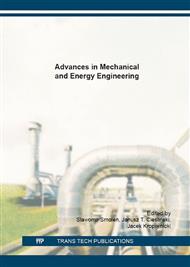[1]
Choi S., Enhancing thermal conductivity of fluids with nanoparticles, Developments and Applications of Non-Newtonian Flows, ASME, FED-Vol. 231/MD-Vol. 66, 1995, pp.99-105.
Google Scholar
[2]
Duan F., Wong T.F. and Crivoi A.: Dynamic viscosity measurement in non-Newtonian graphite nanofluids. Nanoscale Research Letters 2012, 7: 360, http: /www. nanoscalereslett. com/content/7/1/360.
DOI: 10.1186/1556-276x-7-360
Google Scholar
[3]
Yu Z.T. et al.: Increased thermal conductivity of liquid paraffin-based suspensions in the presence of carbon nano-additives of various sizes and shapes, Carbon, vol. 53 (2013) 277–285.
DOI: 10.1016/j.carbon.2012.10.059
Google Scholar
[3]
a] Yu W., Xie H., Bao D.: Enhanced thermal conductivities of nanofluids containing graphene oxide nanosheets, Nanotechnology 21 (2010) 055705.
DOI: 10.1088/0957-4484/21/5/055705
Google Scholar
[4]
Xie H., Yu W. and Li Y.: Thermal performance enhancement in nanofluids containing diamond nanoparticles. J. Phys. D: Appl. Phys. 42 (2009) 095413 (5pp. ) doi: 10. 1088/0022-3727/42/9/095413.
DOI: 10.1088/0022-3727/42/9/095413
Google Scholar
[5]
Xie H., Yu W., Yang Li Y., Chen L.: Discussion on the thermal conductivity enhancement of nanofluids. Xie et al. Nanoscale Research Letters 2011, 6: 124, http: /www. nanoscalereslett. com/content/6/1/124.
DOI: 10.1186/1556-276x-6-124
Google Scholar
[6]
Ma H. B., Wilson C., Borgmeyer B., Park K., Yu Q., Choi S. U. S. and Tirumala M.: Effect of nanofluid on the heat transport capability in an oscillating heat pipe. Applied Physics Letters 88, 143116 (2006); doi: 10. 1063/1. 2192971.
DOI: 10.1063/1.2192971
Google Scholar
[7]
Nasiri A., Shariaty-Niasar M., Rashidi A.M., Khodafarin R.: Effect of CNT structures on thermal conductivity and stability of nanofluid, Int. J. Heat and Mass Transfer, 55 (2012) 1529–1535.
DOI: 10.1016/j.ijheatmasstransfer.2011.11.004
Google Scholar
[8]
Nanda J., Maranville C., Bollin S.C., Sawall D., Ohtani H., Remillard J.T., Ginder J.M.: Thermal conductivity of single-wall carbon nanotube dispersions: role of interfacial effects. J. Phys Chem C 2008, 112(3): 654–658.
DOI: 10.1021/jp711164h
Google Scholar
[9]
Martin-Gallego M. et al.: Thermal conductivity of carbon nanotubes and graphene in epoxy nanofluids and nanocomposites. Martin-Gallego et al.: Nanoscale Research Letters 2011, 6: 610 http: /www. nanoscalereslett. com/content/6/1/610.
DOI: 10.1186/1556-276x-6-610
Google Scholar
[10]
Choi S. U. S., Zhang Z. G., Yu W., Lockwood F. E., and Grulke E. A.: Anomalous thermal conductivity enhancement in nanotube suspensions. Applied Physics Letters 79, 2252 (2001); doi: 10. 1063/1. 1408272.
DOI: 10.1063/1.1408272
Google Scholar
[11]
Chen L., Xie H., Li Y., Yu W.: Nanofluids containing carbon nanotubes treated by mechanochemical reaction, Thermochim. Acta 477 (1–2) (2008) 21–24.
DOI: 10.1016/j.tca.2008.08.001
Google Scholar
[12]
Phuoc T.X., Massoudi M., Chen R. -H.: Viscosity and thermal conductivity of nanofluids containing multi-walled carbon nanotubes stabilized by chitosan, Int. J. Therm. Sci. 50 (1) (2011) 12–18.
DOI: 10.1016/j.ijthermalsci.2010.09.008
Google Scholar
[13]
Garg P., Alvarado J.L., Marsh C., Carlson T.A., Kessler D.A., Annamalai K.: An experimental study on the effect of ultrasonication on viscosity and heat transfer performance of multi-wall carbon nanotube-based aqueous nanofluids, Int. J. Heat Mass Transfer 52 (21–22) (2009).
DOI: 10.1016/j.ijheatmasstransfer.2009.04.029
Google Scholar
[14]
Geim A.K.: Graphene: Status and Prospects, Science 324 (5934) (2009) 1530–1534.
DOI: 10.1126/science.1158877
Google Scholar
[15]
Kole M., Dey T.K.: Investigation of thermal conductivity, viscosity, and electrical conductivity of graphene based nanofluids, J. Applied Physics 113, 084307 (2013); doi: 10. 1063/1. 4793581.
DOI: 10.1063/1.4793581
Google Scholar
[16]
Yu W., Xie H. and Bao D.: Enhanced thermal conductivities of nanofluids containing graphene oxide nanosheets. Nanotechnology 21 (2010) 055705 (7pp) doi: 10. 1088/0957-4484/21/5/055705.
DOI: 10.1088/0957-4484/21/5/055705
Google Scholar
[17]
Mehrali M. et al.: Investigation of thermal conductivity and rheological properties of nanofluids containing graphene nanoplatelets. Nanoscale Research Letters 2014, 9: 15, http: /www. nanoscalereslett. com/content/9/1/15.
DOI: 10.1186/1556-276x-9-15
Google Scholar
[18]
Fang X. et al.: Increased thermal conductivity of eicosane-based composite phase change materials in the presence of graphene nanoplatelets. Energy Fuel 2013, 27(7): 4041–4047.
DOI: 10.1021/ef400702a
Google Scholar
[19]
Hwang Y. et al.: Stability and thermal conductivity characteristics of nanofluids, Thermochimica Acta 455 (2007) 70–74.
Google Scholar
[20]
Bandean D.C., Smoleń S., Cieśliński J.T.: Working fluid selection for Organic Rankine Cycle applied to heat recovery systems. World Renewable Energy Congress 2011, Linköping, Sweden, 8-11 May 2011, [CD], Linköping University, (2011).
DOI: 10.3384/ecp11057772
Google Scholar
[21]
Maxwell J.C.: A treatise on electricity and magnetism, 2nd edition, Oxford, (1904).
Google Scholar
[22]
Timofeeva E.V., Gavrilov A.N., McCloskey J.M., Tolmachev Y.V., Sprunt S., Lopatina L.M., Selinger J.V.: Thermal conductivity and particle agglomeration in alumina nanofluids: experiment and theory. Phys Rev E, 2007, 76: 061203-061216.
DOI: 10.1103/physreve.76.061203
Google Scholar
[23]
Hamilton R.L., Crosser O.K.: Thermal conductivity of heterogeneous two-component systems, Industrial & Engineering Chemistry Fundamentals 1 (3), 1962, p.187–191.
DOI: 10.1021/i160003a005
Google Scholar
[24]
Duangthongsuk W., Wongwises S.: Measurement of temperature-dependent thermal conductivity and viscosity of TiO2-water nanofluids, Experimental Thermal and Fluid Science 33, 2009, 706–714.
DOI: 10.1016/j.expthermflusci.2009.01.005
Google Scholar
[25]
Yu W., Choi S.U.S.: The role of interfacial layers in the enhanced thermal conductivity of nanofluids: a renovated Maxwell model, Journal of Nanoparticle Research 5 (2003) 167–171.
DOI: 10.1023/a:1024438603801
Google Scholar
[26]
Einstein A.: Eine neue Bestimmung der Moleküldimensionen, Annalen der Physik 19 (1906) 289–306.
DOI: 10.1002/andp.19063240204
Google Scholar
[27]
Brinkman H.C.: The viscosity of concentrated suspensions and solution, Journal of Chemical Physics 20, 1952, 571–581.
Google Scholar
[28]
Nielsen L.E.: Generalized equation for the elastic moduli of composite materials, J. Appl. Phys. 41 (11), 1970, 4626–4627.
DOI: 10.1063/1.1658506
Google Scholar
[29]
Krieger I.M. and Dougherty T.J.: A Mechanism for Non-Newtonian Flow in Suspensions of Rigid Spheres. J. Rheology, 3 (1959) 137-152.
DOI: 10.1122/1.548848
Google Scholar
[30]
Vajjha R.S., Das D.K.: A review and analysis on influence of temperature and concentration of nanofluids on thermophysical properties, heat transfer and pumping power, Int. J. Heat and Mass Transfer 55, 2012, p.4063–4078.
DOI: 10.1016/j.ijheatmasstransfer.2012.03.048
Google Scholar
[31]
Wang X., Xu X., Choi S.U.S.: Thermal conductivity of nanoparticles–fluid mixture, Journal of Thermophysics Heat Transfer 13 (4) (1999) 474–480.
DOI: 10.2514/2.6486
Google Scholar


